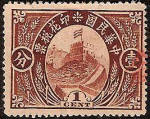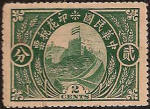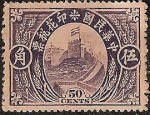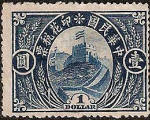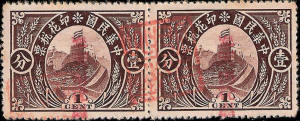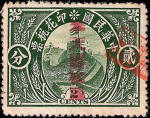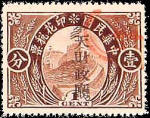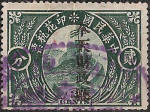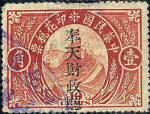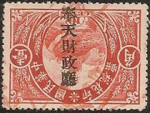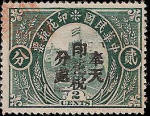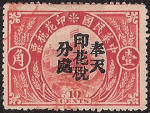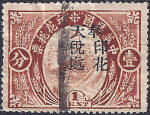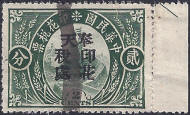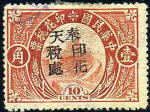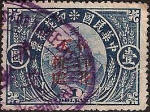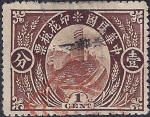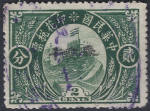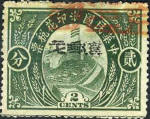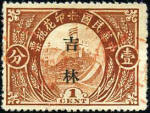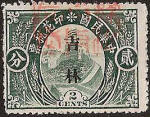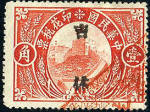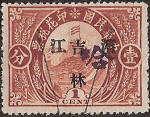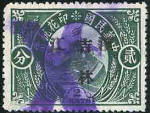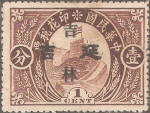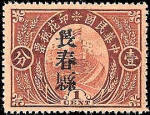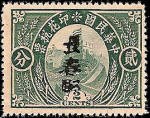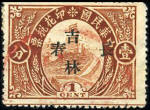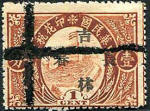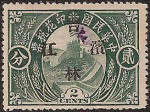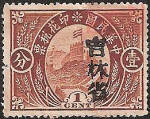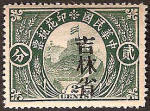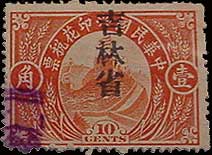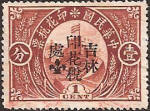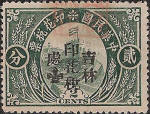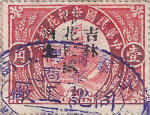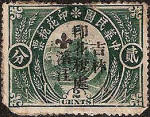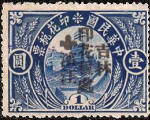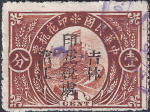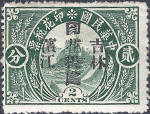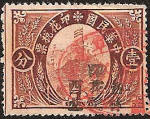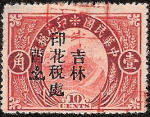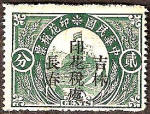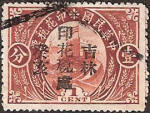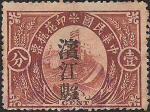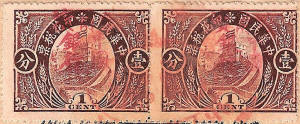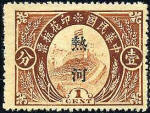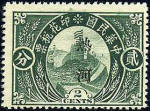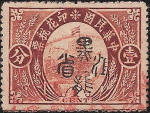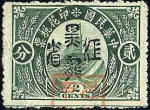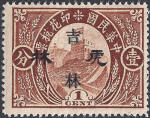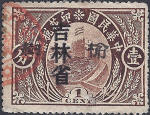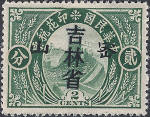 |
|||||||
|
Forerunners Mukden Opium Destroy Certificates Manchukuo Manchukuo Marriage Registration Tax Harbin & Mukden Municipal Revenues Kwantung
|
Pre-Manchukuo Revenue Stamps This page shows a selection of the revenue stamps in use prior to the formation of Manchukuo in March 1932. To see a selection of pre-Manchukuo revenues on original documents - click here. |
||||||
|
|
|||||||
|
The Great Wall Revenue Issue In 1907 the Empress Dowager wanted to tighten control of taxes in China. To achieve this she wanted tax stamps of a high quality that could be produced in China under strict control. To further this aim she employed two Americans, designer Lorenzo Hatch and his assistant, a master engraver, William Grant. They were given free reign and an almost unlimited budget with which they imported the best printing and engraving equipment available. The Empress died shortly after the contract had been awarded but the project continued and work began to produce the new stamps at the Chinese Bureau of Engraving and Printing. Sheets from this facility have the imprint Chinese Bureau of Engraving and Printing in the bottom margin. Stamp duty came into force on 21st October 1912 with the introduction of the "Stamp Act", (in the provinces this was implemented 1st March 1913). In 1916 production was moved to a new facility The Bureau of Printing and Engraving, Peking, China, and this imprint appears on the bottom margin of stamps produced at the new works. The quality of these stamps is at least equal to that of any postage stamps produced during this period. The early issues are known as (Type 1), they were then re-printed with new dies from 1916 onwards and these are described as (Type 2). Examples of the control overprints shown below can exist on both issues. Books say slight differences can be detected in two printings of the 1c and 2c examples (although in my opinion the 2c stamps are to all intents and purposes identical). To see the difference in the 1c stamp look at the character 壹 "yi" meaning 1, the line at the foot kicks up on the first issue (Type 1), strangely the later issue (Type 2) is harder to find, to see an enlargement click here. The original stamps were engraved, but subsequent reprints and local issues were produced by a range of methods with minor changes occurring in the design, size, colour and perforation. The so called wide and narrow printings are likely to be the result of paper stretching or shrinking and not therefore genuine varieties. These stamps were used for tax charging purposes in the form of a purchase tax, a tiny amount charged for every business transaction. In 1917 this charge was extended to passports, marriage certificates, examination certificates, diplomas, guarantees and a host of other legal or semi-legal forms. The main resistance to this tax came from foreign companies operating in China but eventually even they were forced to comply. Each province, town and office had its own overprint, and these were applied in a wide range of colours, sizes and styles. It is said that there may be as many as 20,000 different varieties. Some control overprints are shown below, each are part of a full set similar to the one shown above.
1917 Mukden Provincial Department of Finance (in red) Known values 1c, 2c and 10c, this overprint also appears in vermillion.
1918 Mukden Provincial Department of Finance (in black) Known values 1c, 2c, 10c, 50c and 1 Yuan Overprint Inverted
1919 Mukden Revenue Tax Office Known values 1c, 2c, 10c, 50c and 1 Yuan
1920 Mukden Revenue Tax Sub Office Type 1* Type 2* Known values 1c, 2c, 10c, 50c and 1 Yuan. Additional characters reading "Temporarily Used for Judicial Stamps at Fengtian" have been found on this issue. Presumably this is due to a shortage of the special Documentary Tax stamps used in the courts.
Pre 1920 - Fengtian (Mukden) Numbered Post Offices (Example PO.1 奉郵一) Post Office 1 Post Office 10 Post Office 10 Post Office 27 Known values 1c, 2c, 10c, 50c and 1 Yuan Wetterling lists 90 Fengtian Post Offices with this type of mark. Numbered Post Offices also appear for Kirin (Jilin) starting with 吉. (Example 吉郵一).
1921 (2 Character 吉林 ) Kirin (Jilin) Narrow Spacing Town and Bureau names are added to this stamp. Known values 1c, 2c, 10c, 50c and 1 Yuan.
1923 (2 Character 吉林 ) Kirin (Jilin) Wide Spacing Known values 1c, 2c, 10c, 50c and 1 Yuan.
1921 Kirin Bureau (Narrow Spacing) - Pin Chiang This shows the narrow spaced Kirin stamp with the addition of the Pin Chiang 濱江 control characters. The first stamp is unusual it also has an extra overprinted 哈 Ha character in purple, presumably short for Harbin. Known values 1c, 2c, 10c, 50c and 1 Yuan.
1921 Kirin Bureau (Wide Spacing) - Yenki This shows the narrow spaced Kirin stamp with the addition of the Yenki 延吉 control characters. Known values 1c, 2c, 10c, 50c and 1 Yuan.
1920 Changchun Hsien (County) 長春縣 Known values 1c, 2c, 10c, 50c and 1 Yuan.
1921 Kirin Bureau (Narrow Spacing) - Chang Chun This shows the narrow spaced Kirin stamp with the addition of the 長春 Changchun control characters. Known values 1c, 2c, 10c, 50c and 1 Yuan.
1923 Kirin Bureau (Wide Spacing) - Chang Chun This shows the later wide spaced Kirin stamp with the addition of the 長春 Changchun control characters. Known values 1c, 2c, 10c, 50c and 1 Yuan.
1923 Kirin Bureau Pin Chiang (wide spacing) This shows the wide spaced Kirin stamp with the addition of the Pin Chiang 濱江 control characters. (The company that cancelled the 10c stamps is Chinese East Railway, Commercial School) Known values 1c, 2c, 10c, 50c and 1 Yuan.
1920 (3 Character 吉林省 Kirin (Jilin) Province Known values 1c, 2c, 10c, 50c and 1 Yuan.
1920 (3 Character 吉林縣 Kirin (Jilin) County The this stamp shows a different bottom character 縣 this means County, this may or may not be a rarity - 省 is far more common. Known values 1c, 2c, 10c, 50c and 1 Yuan.
1919 Kirin Revenue Stamp Bureau Known values 1c, 2c, 10c, 50c and 1 Yuan.
1919 Kirin Revenue Stamp - Harbin Bureau Known values 1c, 2c, 10c, 50c and 1 Yuan.
Pin Chiang Revenue Tax Office Known values 1c, 2c, 10c, 50c and 1 Yuan.
Pin Chiang Revenue Tax Office Known values 1c, 2c, 10c, 50c and 1 Yuan.
Unknown Revenue Tax Office in Kirin This example features the character "酉" above a fluer-de-lis, there are many possible town names beginning with this character in Kirin. Known values 1c, 2c, 10c, 50c and 1 Yuan.
1919 Kirin Revenue Stamp - Changchun Bureau Known values 1c, 2c, 10c, 50c and 1 Yuan.
Kirin Revenue Stamp - 癸亥 Gui-hai Bureau? This example is listed in Wetterling but I have been unable to trace the town. Known values 1c, 2c, 10c, 50c and 1 Yuan.
Pin Chiang (Harbin) Bureau Known values 1c, 2c, 10c, 50c and 1 Yuan.
Harbin - Bank of China 哈爾濱 中国银行 c.1922 This is a red overprint applied to the Great Wall Revenues in red by the Bank of China in Harbin. I have seen no other examples with Bank of China Branch Office overprints so I assume these are something of a rarity. Wetterling lists a large four character 中国银行 Bank of China overprint in black ,so it is known they overprinted these stamps. Probable values 1c, 2c, 10c, 50c and 1 Yuan, the black Bank of China overprint appeared on the full set..
1925 Jehol (Rehe) Province 热河省 Known values 1c, 2c and 10c.
1920 Heilungkiang (Heilongjiang) Province 黑龍江省 The character design is based upon seal script. Now Heilongjiang, the name means Black Dragon River. The 1c overprint is known in two sizes, large and small. Known values 1c, 2c, 10c, 50c and 1 Yuan.
Beware Fake Small Town Overprints Above are a series of overprints that purport to be from small towns in Kirin Province, Hulin, Dunhua, Yushu and Mishan. The towns certainly exist but these overprints (and many more) are bogus and come from an eBay seller based in Shanghai.
|
|||||||
|
My thanks to Tom Shea for his writings on the Great Wall Revenue Stamps in the China Clipper. The items above have been identified by reference to J G Wetterling's, Handbook and Checklist of Chinese Revenue Stamps (Part 1) and The General Catalogue of Chinese Tax Stamps. Editors Wang Ping-wu and Xu Hui-en. Published by China Taxation Publishing Co. |
|||||||

